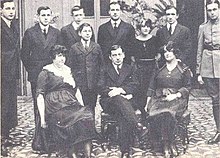 Family Alessandri, of Italian descent, in 1920, with two future presidents of Chile, Arturo Alessandri (1920–1925 and 1932–1938) and Jorge Alessandri (1958–1964) | |
| Total population | |
| c. 52,000 (by birth)[1] c. 600,000 (by ancestry, corresponding to about 3.5% of the total Chilean population)[2] | |
| Regions with significant populations | |
| Valparaíso, Santiago, Concepción | |
| Languages | |
| Chilean Spanish · Italian and Italian dialects | |
| Religion | |
| Roman Catholicism | |
| Related ethnic groups | |
| Italians, Italian Americans, Italian Argentines, Italian Bolivians, Italian Brazilians, Italian Canadians, Italian Colombians, Italian Costa Ricans, Italian Cubans, Italian Dominicans, Italian Ecuadorians, Italian Guatemalans, Italian Haitians, Italian Hondurans, Italian Mexicans, Italian Panamanians, Italian Paraguayans, Italian Peruvians, Italian Puerto Ricans, Italian Salvadorans, Italian Uruguayans, Italian Venezuelans |
Italian Chileans (Italian: italo-cileni; Spanish: ítalo-chilenos) are Chilean-born citizens who are fully or partially of Italian descent, whose ancestors were Italians who emigrated to Chile during the Italian diaspora, or Italian-born people in Chile. It is estimated that about 600,000[2] Chileans are of full or partial Italian ancestry,[3] corresponding to about 3.5% of the total population, while Italians by birth in Chile are about 52,000.[1] In Southern Chile, there were state-conducted Italian immigrant programs though they were not as massive as the German and Croatian immigrant programs. Families settled especially in Capitán Pastene, Angol, Lumaco, and Temuco but also in Valparaiso, Concepción, Chillán, Valdivia, and Osorno. One of the notable Italian influences in Chile is, for example, the sizable number of Italian surnames of a proportion of Chilean politicians, businessmen, and intellectuals, many of whom intermarried into the Castilian-Basque elites.
Italian Chileans, along with French Chileans, contributed to the development, cultivation and ownership of the world-famous Chilean wines from haciendas in the Central Valley, since the first wave of Italians arrived in colonial Chile in the early 19th century.
Italians in immigration to Chile have been present since the arrival of the first Spaniards into the country, such as Captain Giovanni Battista Pastene who helped Pedro de Valdivia's expedition. Thence, with akin Latin culture, Italians have helped forge the nation, with architects (Gioacchino Toesca), painters (Camilo Mori), businessmen (Anacleto Angelini), economists (Vittorio Corbo) and statesmen (Arturo Alessandri).
Since Italian immigration was never massive or organized, the only case of concerted immigration appeared in the town of Capitán Pastene, in the Araucanía Region of southern Chile, where in 1904, 23 families from Emilia-Romagna were left at their own device after being wrongfully enticed to the "riches" of Chile. Today, this small town celebrates a renaissance of their Italic heritage.
- ^ a b "Rapporto Italiani nel Mondo 2013" (in Italian). Retrieved 17 February 2023.
- ^ a b Parvex, Ricardo (2014). "Le Chili et les mouvements migratoires". Hommes & Migrations (1305): 71–76. doi:10.4000/hommesmigrations.2720.
- ^ Thayer Ojeda, Luis (1989). Orígenes de Chile: Elementos Étnicos, Apellidos, Familias. Santiago de Chile: Editorial Andrés Bello. p. 161.